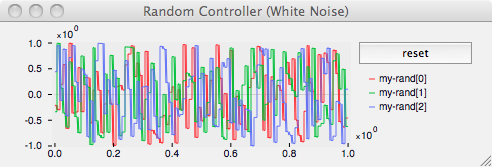Random Controller
Description
Outputs one or more equally distributed random sequences (white noise). The output values range from -1 to 1.

Syntax and Default Values
The 'random controller can be created using the following Mlys (Max), mlys.lua, or Lisp syntax:
In Modalys for Max, this object is named mlys.random:
[mlys.random TOCOMPLETE]
local randomCtrl = modalys.make_controller{ kind="random",
dimension=3,
period=0.01}
(make-controller 'random
dimension
period)
Parameters
The 'random controller takes two arguments:
- dimension: number of dimensions of the output controller.
- period: sampling period (seconds). period=0 means 'every sample'.
The period is used to define the time between the updates of the controller. If zero is given then it updates every sample.
Discussion
The Random Controller is basically a white noise oscillator with an optional sample-and-hold mechanism, since it outputs values between -1 an 1, and has a user-defined sampling period. It is fairly simple to use and can output different random values in multiple dimensions, such as this Lisp example (whose graph is shown above) which outputs 3 dimensions of random values updated every 10 milliseconds:
(setq my-rand (make-controller 'random 3 0.01))
(setq my-string (make-object 'mono-string))
(setq my-string-acc (make-access my-string (const .6) 'trans0))
(setq my-noise (make-controller 'random 1 0))
(setq my-env (make-controller 'envelope 1 '((0 0) (0.1 5) (0.2 2) (0.3 0)) ))
(setq force-ctl (make-controller 'arithmetic 1 "*" my-noise my-env))
(make-connection 'force my-string-acc force-ctl)
★